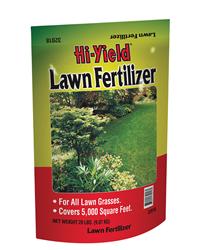
By late March to early April, you should be mowing your lawn by now. Common Bermuda grass likes to be mowed often (3-7 days) at a height of 1 to 2 inches. St. Augustine requires less mowing (5-7 days) and likes to be cut between 3 and 3 1/2 inches tall.
You should also fertilize your lawn and treat it for weed control. However, do not use weed and feed products as a shortcut! Fertilizing your lawn and killing weeds should be two separate events. The majority of weeds and feeds target broadleaf weeds. Applying them too close to trees and shrubs will kill non-targeted plants. For what little time you save, it is not worth the risk.
Once you know how many square feet of lawn you have, you need to select a fertilizer. The numbers on a bag of fertilizer (10-20-0) translate to the percentage of N, P, and K. The first number, Nitrogen (N) is for healthy green growth. Nitrogen is a big component of a healthy lawn. The second number, Phosphorus (P) is for root development. The third number, Potash (K) is a nutrient already in abundance in North Texas soils. Because our soils are typically very alkaline, adding sulfur will encourage healthier grass growth or prepare the soil for the establishment of a new lawn. we have around here will the lawns. Soil testing will help you determine the fertilization “recipe” needed for your lawn!
Foreman’s General Store stocks a wide variety of very effective traditional as well as organic weed control and fertilizer products. We recommend these top sellers to get your grass growing right this Spring:
Nature’s Wisdom 20% Vinegar 20% Vinegar is a staple organic option for non-selective control of broadleaf & grassy weeds
Hi-Yield 15-0-10 Lawn Fertilizer An excellent plant food for all types of grasses. Foreman’s carries the 20 lb. bag which covers up to 5000 square feet of lawn.
You can find more information on soil testing at these two links:
http://texasplantandsoillab.com/
Stop by Foreman’s General Store for Hi-Yield Weed & Feed.
Tags: fertilizer, Fort Worth Texas, lawns, North Texas, soils, Texas A&M



